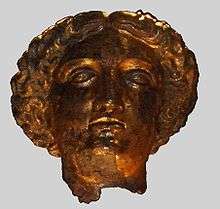Bath curse tablets
The Bath curse tablets are a collection of about 130 Roman era curse tablets (or defixiones in Latin) discovered in 1979/1980 in the English city of Bath. The tablets invoke the intercession of the goddess Sulis Minerva in the return of stolen goods and to curse the perpetrators of the thefts. Inscribed mostly in British Latin, they have been used to attest to the everyday spoken vernacular of the Romano-British population of the second to fourth centuries A.D.
Discovery and description

The Roman baths and temple dedicated to the goddess Sulis Minerva in the English city of Bath (founded by the Romans as Aquae Sulis) were excavated between 1978 and 1983 by a team led by Barry Cunliffe and Peter Davenport.[1] In 1979/1980, around 130 tablets were discovered in an excavation of the "Sacred Spring" under the King's Bath.[2] The spring had been temporarily diverted to facilitate the excavation, revealing a huge array of Roman era items including the tablets.[3]
The tablets, some in a fragmentary state,[4] were small and rectangular and initially were assumed to be made of lead, although subsequent metallurgical analysis revealed that they are, in fact, made of lead alloyed with tin, with occasional traces of copper.[5] Some of the tablets were cast under pressure into thin, flexible sheets with a finish as smooth as paper whereas others appear to have been roughly hammered out from a molten lump.[6] Most of the tablets were inscribed, either with Roman capitals or with cursive script, but the expertise of the lettering varied.[6] Some of the tablets had markings that appear to be an illiterate imitation of lettering, for example repetitive lines of crosses or sevens, and some were completely blank.[7]
The tablets were put on display in the Roman Baths Museum in Bath, where they continue to be available to be viewed by the public.[8] The inscriptions on the tablets were published in full in 1988 by historian Roger Tomlin.[9]
Inscriptions
The tablets were identified as “curse tablets” dating from the second to fourth centuries A.D.[4] Curse tablets are small metal sheets inscribed with curses against specific people and were used in popular magic throughout the Roman world.[10]
Language
Most of the inscriptions are in colloquial Latin,[11] and specifically in the Vulgar Latin of the Romano-British population, known as "British Latin".[4][12] Two of the inscriptions are in a language which is not Latin, although use Roman lettering, and may be in a British Celtic language.[13] If this should be the case, they would be the only examples of a written ancient British Celtic language; however, there is not yet scholarly consensus on their decipherment.[14]
Content
All but one of the 130 Bath curse tablets concern the restitution of stolen goods and are a type of curse tablet known as "prayers for justice".[15] The complained of thefts are generally of personal possessions from the baths such as jewellery, gemstones, money, household goods and especially clothing.[16] Theft from public baths appears to have been a common problem as it was a well-known Roman literary stereotype and severe laws existed to punish the perpetrators.[17] Most of the depositors of the tablets (the victims of the thefts) appear to have been from the lower social classes.[18]
The inscriptions generally follow the same formula, suggesting it was taken from a handbook: the stolen property is declared as having been transferred to a deity so that the loss becomes the deity’s loss; the suspect is named and, in 21 cases, so is the victim; the victim then asks the deity to visit afflictions on the thief (including death) not as a punishment but to induce the thief to hand the stolen items back.[16] The deity whose help was invoked is Sulis, and the tablets were deposited by the victims in the spring that was sacred to her.[3]
Examples

A typical example reads:
The formula "whether man or woman or whether slave or free" is typical, and the following example is unusual in two respects.[21] Firstly it adds the words "whether pagan or Christian" and secondly the text was written in reversed lettering:
- "Whether pagan or Christian, whether man or woman, whether boy or girl, whether slave or free whoever has stolen from me, Annianus [son of] Matutina (?), six silver coins from my purse, you, Lady Goddess, are to exact [them] from him. If through some deceit he has given me...and do not give thus to him but reckon as (?) the blood of him who has invoked his upon me."[21][22]
Many name the suspected thieves:
Some of the inscriptions are very specific in the afflictions requested and reveal the intensity of the victim's anger:[25]
- "Docimedis has lost two gloves and asks that the thief responsible should lose their minds [sic] and eyes in the goddess' temple."[26][27]
- "May he who carried off Vilbia from me become liquid as the water. May she who so obscenely devoured her become dumb"[25][28]
- "...so long as someone, whether slave or free, keeps silent or knows anything about it, he may be accursed in (his) blood, and eyes and every limb and even have all (his) intestines quite eaten away if he has stolen the ring or been privy (to the theft)."[29][30]
One of the suspected British Celtic inscriptions has been translated as:
- "The affixed – Deuina, Deieda, Andagin, (and) Uindiorix – I have bound"[31]
An alternative translation of the above inscription is:
- "May I, Windiorix for/at Cuamena defeat (alt. summon to justice) the worthless woman, oh divine Deieda."[32]
-

Complaint about theft of a woman's cape.
-

Complaint about theft of Vilbia - probably a woman
-

Complaint about theft of a cloak and bathing tunic
-

A list of names
-

A text in British Celtic - the only words in British Celtic known to survive anywhere
-

Folded curse
Significance
The Bath curse tablets are the most important record of Romano-British religion yet published.[33] Curse tablets are of particular use in evidencing the Vulgar Latin of everyday speech,[10] and, since their publication in 1988, the Bath inscriptions have been used as evidence of the nature of British Latin.[4][9] Additionally, the contents of the inscriptions have been used as evidence of popular attitudes to crime and the system of justice.[34]
See also
References
- ↑ "The end of Roman Bath". Current Archaeology (217). 2008. Retrieved 23 November 2013.
- ↑ Gordon, Richard; Simon, Francisco Marco (2010). Magical Practice in the Latin West. p. 15. ISBN 9789004179042.
- 1 2 Wilson, Roger (1988). A guide to the Roman remains in Britain. p. 109. ISBN 0094686807.
- 1 2 3 4 J.N. Adams (1992). "British Latin: the text, interpretation and language of the Bath Curse Tablets". Britannia. 23: 1. doi:10.2307/526102.
- ↑ Flint, Valerie; et al. (1998). Witchcraft and Magic in Europe: Ancient Greece and Rome Vol.2. p. 11. ISBN 0485891026.
- 1 2 Tomlin, Roger "Writing and Communication", p.152 in Allason-Jones, Lindsay (ed.) (2011). Artefacts in Roman Britain: Their Purpose and Use. ISBN 0521860121.
- ↑ Flint, Valerie; et al. (1998). Witchcraft and Magic in Europe: Ancient Greece and Rome Vol.2. p. 60. ISBN 0485891026.
- ↑ "Archaeology Collection – Roman Baths Museum: Bath & North East Somerset Heritage Services Division". Find My Library. Retrieved 23 November 2013.
- 1 2 Adams, James N. (2008). The Regional Diversification of Latin 200 BC – AD 600. pp. 579–580. ISBN 978-0521881494.
- 1 2 Herman, Jozsef (2000) [1967]. Vulgar Latin. pp. 20–21. ISBN 0271020016.
- ↑ Adams, Geoffrey (2005). Romano-Celtic Elites and their Religion. p. 68. ISBN 0975844512.
- ↑ Carver, Martin (2006). The Cross Goes North: Processes of Conversion in Northern Europe, AD 300–1300. p. 89. ISBN 1843831252.
- ↑ R.S.O Tomlin (1987). "Was Ancient British Celtic ever a written language? Two texts from Roman Bath". Bulletin of the Board of Celtic Studies. 34: 18–25.
- ↑ Koch, John T. (2006). Celtic Culture: A Historical Encyclopedia. p. 970. ISBN 1851094407.
- ↑ Flint, Valerie; et al. (1998). Witchcraft and Magic in Europe: Ancient Greece and Rome Vol.2. pp. 37–38. ISBN 0485891026.
- 1 2 Gager, John G. (1999). Curse tablets and binding spells from the ancient world. p. 193. ISBN 0195134826.
- ↑ Gager, John G. (1999). Curse tablets and binding spells from the ancient world. p. 193 note 73. ISBN 0195134826.
- ↑ Tomlin, Roger (1988). Tabellae Sulis: Roman inscribed tablets of tin and lead from the sacred spring at Bath. pp. 97–98. ISBN 0947816003.
- ↑ Fagan, Garrett G. (2002). Bathing in Public in the Roman World. p. 37. ISBN 0472088653.
- ↑ A. Kropp (2008). Defixiones: Ein aktuelles Corpus lateinischer Fluchtafeln. Speyer. 03-02-24. EDCS-ID: EDCS-17900027.
- 1 2 Gager, John G. (1999). Curse tablets and binding spells from the ancient world. p. 195. ISBN 0195134826.
- ↑ AE 1982, 00667
- ↑ Gager, John G. (1999). Curse tablets and binding spells from the ancient world. p. 194. ISBN 0195134826.
- ↑ AE 1982, 00658
- 1 2 Dvorjetski, Estee (2007). Leisure, Pleasure and Healing: Spa Culture and Medicine in Ancient Eastern Mediterranean. p. 103. ISBN 978-9004156814.
- ↑ Tomlin, Roger (1988). Tabellae Sulis: Roman inscribed tablets of tin and lead from the sacred spring at Bath. pp. 114–115. ISBN 0947816003.
- ↑ AE 1986, 00465
- ↑ AE 2006, 00704
- ↑ Collins, Derek (2008). Magic in the Ancient Greek World. pp. 86–87. ISBN 9781405132381.
- ↑ AE 1983, 00633
- ↑ Mees, Bernard (2009). Celtic Curses. Boydell & Brewer. p. 35.
- ↑ Sims-Williams, Patrick (2007). "Common Celtic, Gallo-Brittonic, and Insular Celtic" in Gauloise et celtique continental, P-Y Lambert, G-J Pinault, eds. Droz. p. 327.
- ↑ Hornblower, Simon; et al. (2012). The Oxford Classical Dictionary. p. 128. ISBN 0199545561.
- ↑ Uhalde, Kevin (2007). Expectations of justice in the age of Augustine. pp. 27–30. ISBN 0812239873.